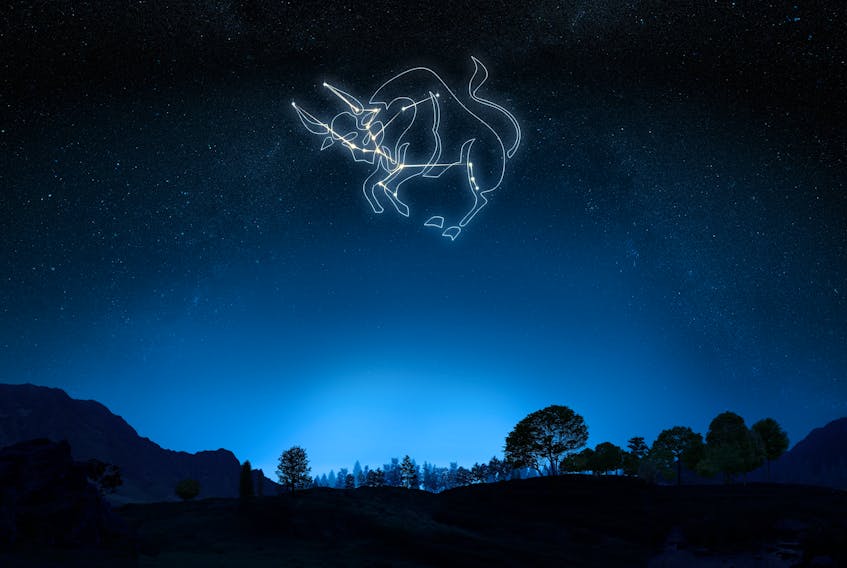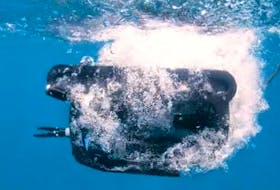
The constellation of Taurus — the Bull is a prominent constellation in the night sky in January. Located about halfway up from the southern horizon by mid-evening, Taurus sits just to the upper right of Orion — the Hunter. Easily distinguished by the bright, red-coloured, first magnitude star, Aldebaran, this constellation, in Greek mythology, represents the leader of the Olympian gods — Zeus. It depicts the front half of a large, white bull, the form he took to seduce the mortal Phoenician princess, Europa (whose name eventually was given to modern day Europe). Taurus is one of the oldest recorded constellations, thought to be represented in the famous Hall of the Bulls cave drawings in Lascaux, France, which date back to around 15,000 BC. It marked the location of the Sun during the spring equinox for the people of the early Bronze Age.
The Hyades star cluster, with its hundreds of stars, forms the general shape of the bull’s head, with the five brighter stars depicting the distinctive V-shape asterism of the bull’s horns. At a distance of 153 light years, the Hyades (named for the five daughters of the titan, Atlas, and one of the Oceanide sea-nymphs) is the closest, open-star cluster to Earth. Though appearing, by line of sight, to be part of the Hyades, Aldebaran is actually only approximately 65 light years from Earth. The cluster’s name — Hyades — comes from the ancient Greek “to rain”, as this cluster’s appearance in the night sky coincided with the rains of winter. The famous and beautiful Pleiades open-star cluster is easily spotted about halfway along the bull’s back. This star cluster, known as “The Seven Sisters” (the seven daughters of Atlas and another sea-nymph, Pleione) is depicted in numerous cultures around the world, among them those of Britain, Australia, North America and Siberia. This cluster has a distinctive, dipper-shaped appearance to it, and, due to its location so prominently and high in the night sky, is often mistaken for the Little Dipper (Ursa Minor).
Three meteor showers appear to originate from the area of Taurus. The North Taurids usually appear between Oct. 12 - Dec. 2, with the peak occurring between Nov. 4 - 7. The Southern Taurids can be seen from around Sept. 17 until Nov. 27, the peak falling between Oct. 30 - Nov.7, often coinciding with the North Taurids. The third meteor shower - the Beta Taurids - are a summer shower, occurring each year between June 5 - July 18, with the peak on June 29.
Venus, our “evening star”, is still visible at dusk above the SW horizon. It sets around 7:30 p.m., nearly 3 hrs after the Sun. Mars is visible in the SE, rising in the pre-dawn sky shortly before 5 a.m., and remaining visible until about 7 a.m. Mercury, Jupiter and Saturn are all too close to the Sun, and are not presently visible.
The Quadrantid meteor shower occurs during the overnight/pre-dawn hours of Jan. 3 - 4. These meteors are the remnants of the asteroid 2003 EH1 (now classified as an extinct comet) discovered in March 2003. The meteors shower itself is named after the now defunct constellation of Quadrant Muralis (now replaced by that of Bootes — the Herdsman.), from which the shower’s radiant was discovered in 1835. Expect to see 40+ bright meteors/hr from a dark site.
Until next time, I wish you all a very Happy New Year, and, of course, clear skies.
Events:
- Jan. 1 - Moon at apogee (farthest from Earth)
- Jan. 3 - First Quarter Moon.
- Jan. 3/4 - Quadrantid meteor shower peak
Glenn K. Roberts lives in Stratford, P.E.I., and has been an avid amateur astronomer since he was a small child. His column, Atlantic Skies, appears each week. He welcomes comments from readers, and anyone who would like to do so is encouraged to email him at [email protected].









